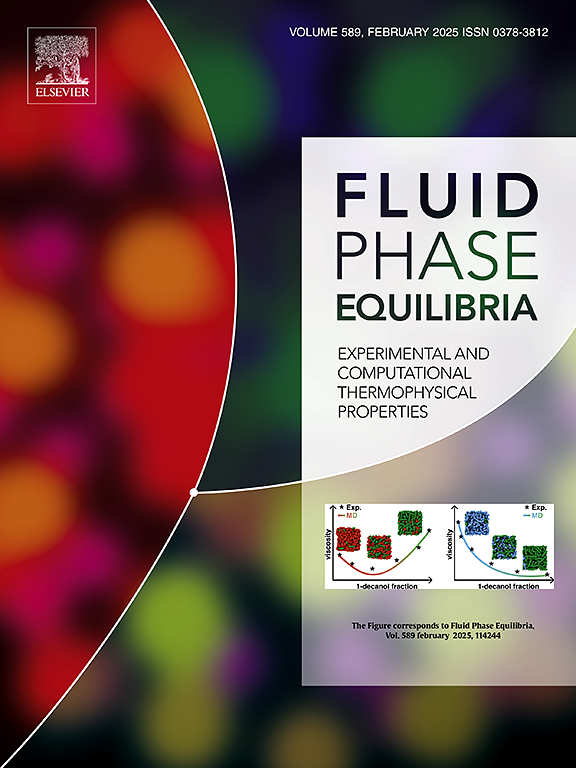Density, viscosity, and CO2 solubility properties of solvents composed of tetrabutylammonium bromide and carboxylic acids
IF 2.7
3区 工程技术
Q3 CHEMISTRY, PHYSICAL
引用次数: 0
Abstract
Hydrophobic solvent mixtures with low viscosities are promising for industrial gas absorption applications. This study examined the density, viscosity, and CO2 solubility properties of two hydrophobic solvent mixtures. Mixtures of tetrabutylammonium bromide (TBAB) with hexanoic acid (HA) and octanoic acid (OA) in a molar ratio of 1:3 (denoted as TBAB3HA and TBAB3OA, respectively) were examined. Measurements were performed over the temperature range of 278.15–353.15 K at atmospheric pressure, and high-pressure densities were measured at 298.15, 313.15, and 333.15 K up to 50 MPa. The density and viscosity data were well correlated using a linear equation and the Vogel–Fulcher–Tammann equation, respectively, while the high-pressure densities were described by the Tait equation. Furthermore, the saturated vapor and liquid densities of CO2, along with its solubility in the TBAB3HA and TBAB3OA systems, were measured at pressures below 8 MPa and at temperatures of 298.15, 313.15, and 333.15 K. The CO2 solubility was well represented by the Peng–Robinson equation of state. Moreover, a previously developed density-correlation equation was modified to model the pressure–volume–temperature–composition relationship for the CO2 + TBAB3HA and CO2 + TBAB3OA systems. This modified equation was further used to determine the partial molar volumes of CO2 in these solvents, which were analyzed using the Lyckman method to gain insights into CO2 absorption behavior. Due to their low viscosities and high CO2 solubilities, TBAB3HA and TBAB3OA are promising candidates for CO2 capture and storage.
由四丁基溴化铵和羧酸组成的溶剂的密度、粘度和CO2溶解度特性
低粘度的疏水溶剂混合物在工业气体吸收方面具有广阔的应用前景。本研究考察了两种疏水溶剂混合物的密度、粘度和CO2溶解度。研究了四丁基溴化铵(TBAB)与己酸(HA)和辛酸(OA)的摩尔比为1:3的混合物(分别记为TBAB3HA和TBAB3OA)。在278.15 ~ 353.15 K的大气压下进行了测量,在298.15、313.15和333.15 K至50 MPa的高压密度下进行了测量。密度和粘度数据分别用线性方程和Vogel-Fulcher-Tammann方程进行了很好的关联,而高压密度数据则用Tait方程进行了描述。此外,在压力低于8 MPa,温度分别为298.15、313.15和333.15 K时,测量了CO2在TBAB3HA和TBAB3OA体系中的饱和蒸汽和液体密度及其溶解度。CO2溶解度可以用Peng-Robinson状态方程很好地表示。此外,修改了先前建立的密度相关方程,以模拟CO2 + TBAB3HA和CO2 + TBAB3OA体系的压力-体积-温度-组成关系。该修正方程进一步用于确定这些溶剂中CO2的偏摩尔体积,并使用Lyckman方法对其进行分析,以了解CO2的吸收行为。由于其低粘度和高CO2溶解度,TBAB3HA和TBAB3OA是CO2捕获和储存的有希望的候选者。
本文章由计算机程序翻译,如有差异,请以英文原文为准。
求助全文
约1分钟内获得全文
求助全文
来源期刊

Fluid Phase Equilibria
工程技术-工程:化工
CiteScore
5.30
自引率
15.40%
发文量
223
审稿时长
53 days
期刊介绍:
Fluid Phase Equilibria publishes high-quality papers dealing with experimental, theoretical, and applied research related to equilibrium and transport properties of fluids, solids, and interfaces. Subjects of interest include physical/phase and chemical equilibria; equilibrium and nonequilibrium thermophysical properties; fundamental thermodynamic relations; and stability. The systems central to the journal include pure substances and mixtures of organic and inorganic materials, including polymers, biochemicals, and surfactants with sufficient characterization of composition and purity for the results to be reproduced. Alloys are of interest only when thermodynamic studies are included, purely material studies will not be considered. In all cases, authors are expected to provide physical or chemical interpretations of the results.
Experimental research can include measurements under all conditions of temperature, pressure, and composition, including critical and supercritical. Measurements are to be associated with systems and conditions of fundamental or applied interest, and may not be only a collection of routine data, such as physical property or solubility measurements at limited pressures and temperatures close to ambient, or surfactant studies focussed strictly on micellisation or micelle structure. Papers reporting common data must be accompanied by new physical insights and/or contemporary or new theory or techniques.
 求助内容:
求助内容: 应助结果提醒方式:
应助结果提醒方式:


